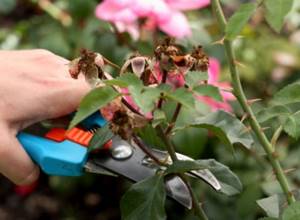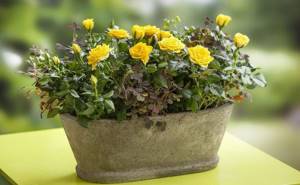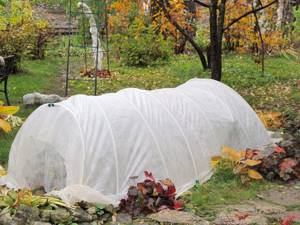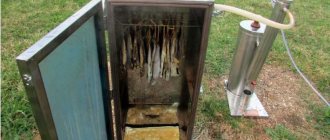Almost every flower garden is decorated with rose bushes. In regions with cool climates, it is difficult to preserve roses without shelter for the winter. It is recommended to trim them first and only then use covering material. It is very important to do everything correctly so that the flowers can once again please you with abundant blooms. Read our article on how to properly prune and cover a rose for the winter.
When to prune roses in autumn?
Autumn pruning of roses is carried out immediately before covering them for the winter. In temperate regions, this is done in early or mid-November, and in areas with harsher weather conditions, pruning should be done in the second half of October. But the timing often has to be adjusted to accommodate climate change. So, during a long dry autumn, you should not rush to shorten the shoots, so as not to cause the awakening of the buds. And if an early cold snap is approaching, you need to have time to prune and cover the bushes before frost.
Weather conditions are also taken into account when planning pruning. For example, if this event is carried out in damp weather, the sections will remain wet for a long time, and then there is a possibility of infection and rot forming on them. Based on this, it is better to plan it on a warm, sunny day, and in the first half of it. In this case, the sections will be able to dry before the evening cold snaps.
How to prune a rose to bloom, how to get constant flowering
Some believe that in order to increase the flowering period, you need to constantly prune. However, this is a controversial issue. Many gardeners believe that it is better not to prune during the flowering period, as the stem loses strength and is restored.
It is recommended to cut the stem down to 5 buds in order to resume the growth of new buds, and during the flowering period, regularly trim off faded flowers.
In any case, dry buds create a sloppy appearance, and removing them won't hurt. In mid-autumn, when the days begin to decrease, the flowers will stop setting, and there is no way to influence this.
So, indoor roses need constant care, only in this case the plant will bloom for a long time and delight its owners.
Pruning the bush plays an important role; this will not only improve the health of the flower, but will also give it a special shape.
What tools will you need to prune roses in the fall?
The procedure requires a minimum set of tools; they are all sold at a hardware store or in a greenhouse along with a rose seedling. When purchasing a bush for planting, you can immediately consult with a specialist and choose the most suitable care kit.
So, to trim bushes you need:
- garden shears and knife. They are used to treat thin young stems;
- pruner Used for cutting branches no more than 2.5 cm thick;
- brush cutter The same pruning shears, but for thicker woody branches. Thanks to the long handles, you can reach the most distant branches. And the gardener’s hands will not suffer from thorns;
- garden hacksaw. It will come in handy if the stems of the bushes are very thick.
To process the cuts, you need to purchase a garden varnish to protect the rose from becoming infected with any infection.
Description of the procedure

Let's go step by step through all the stages of autumn pruning in its standard version.
- First of all, all immature shoots are removed. They are easily identified by their red tint.
- Then the broken, diseased, damaged shoots are shortened to the required length or completely cut off.
- It is also recommended to cut off weak branches that thicken the crown. Go ahead and leave this stage until spring if the rose bush is young or weak.
- In an adult plant, all shoots older than five years of age are cut out.
Important: make the cuts oblique so that moisture does not accumulate on their surface. The location of the cutting site is half a centimeter or 1 cm above the bud.
Preparatory procedures before pruning roses in autumn
Pruning and winterization begin with removing leaves. It is better to do this 5-7 days before winter preparation of the plant:
- collect fallen leaves from the ground;
- carefully remove the leaf blades from the bottom of the stem;
- try not to injure the stem itself;
- extend the procedure over 2-3 days, removing the leaves gradually. If you pick everything at once, it will become stressful for the plant.
Attention! Fungi and viruses overwinter on the foliage, and under protective material they tend to rot and mold.
Tips for the garden, vegetable garden and flower garden
Planting pepper in January 2021 according to the lunar calendar
Sowing pepper seeds for seedlings in 2021 favorable days
How to prepare viburnum for the winter at home recipe
The next step is hilling. Carry it out in dry weather:
- Spray the stems and trunk circle for disinfection. Use a 3% solution of Bordeaux mixture or any other antifungal mixture. Leave the plant to dry for a day.
- Form an earthen bank 20-30 cm high at the base of the stems. Instead of soil, you can simply add the same layer of dry peat or loose compost.
- If the end of autumn is expected to be rainy, throw a film around the bushes at this time. You can cover the entire plant with a plastic cap. This is not protection from frost - the film should be removed on the eve of pre-winter insulation. It is important that the hilled area remains dry until there is permanent frost.
Attention! Hilling will protect the roughened base of the stems from cracking during cold weather. It will also additionally protect the lower buds and roots. The procedures are performed for all varieties of roses.
Pests of indoor roses and control measures
Indoor roses are susceptible to spider mites, and it is almost impossible to prevent their appearance. In the room where the plants are located, the appearance of spider mites is inevitable, so every six months it is necessary to carry out preventive measures, periodically treating the plants from pests. It is advisable not to contain other indoor flowers in a room with roses or place them away from roses so that the mite does not spread throughout the collection. As soon as you notice that the leaves of the rose begin to curl or shrink - this is the first signal of the appearance of spider mites, you should immediately begin treatment for insects.
To do this, the shrubs are taken out into the fresh air and generously sprayed with an insecticide prepared in advance according to the instructions so that the solution gets on both the outside and the back of the leaves. You can pour the remaining solution onto the top layer of soil and wipe the window sills and shelves where the roses were previously located. Attention, when using any drugs you must use personal protective equipment. Processing is carried out strictly with rubber gloves and a respiratory mask, not in windy weather.
If the roses have been outdoors all summer, before bringing them into the house, be sure to inspect the plants for possible pests (aphids, spider mites, powdery mildew, thrips) and treat them with appropriate preparations according to the instructions.

We told you how to care for roses at home. If you follow all these tips, your indoor rose will delight you with luxurious blooms for a long time. It only remains to add that if you were given a gift or you yourself purchased a potted rose in a store, do not rush to replant it. Let the plant get used to its new place within a couple of weeks.
Pruning roses in autumn
For pruning there are rules that must be followed:
You need to trim the rose with a good, sharp pruning shears; it is better to cut down old thick branches with a hacksaw.
Each cut should have a smooth surface, without creases.
The shoots are cut at an angle so that moisture does not stagnate in them.
A distance of 1.5 cm is maintained between the bud and the cut.
Rose bushes need to be trimmed at the end of autumn, before covering. The exact month depends on climatic conditions. For the middle zone - this is the end of October, for the northern regions - a couple of weeks earlier.
In order, the damaged branches are cut off first, then the leaves with buds, and finally the young shoots that have not had time to ripen. Green shoots need to be trimmed until the white core appears.
The pruning procedure should be carried out in dry weather, without strong wind.
All cut parts must be removed from the area to prevent the development of fungi.
Proper care of roses at the end of summer
Before you start pruning roses, you need to take care of feeding. The best time for this in the middle zone is August. Nitrogen is excluded from fertilizers; it activates the growth of green mass. At this time, the best fertilizer is one containing potassium and phosphorus.
At the beginning of September, watering is repeated with water with superphosphate and potassium sulfate, 15 g per 10 liters. Rose bushes can be sprayed with this solution, but the concentration can be reduced by 3 times.
From the end of summer, loosening the soil stops so as not to cause excessive root formation and the appearance of weak shoots. Starting in the fall, all new buds are cut off with pruning shears.
When to cover roses for the winter?
By freeing the roses from their leaves, you will give them a signal that it is time to rest. Allow the cuts and cuts to dry thoroughly and begin covering the bushes for the winter. However, you should not rush too much, since in the warm, long autumn, roses will continue to grow without leaves, and if they are covered at this time, the plant buds may dry out and die. At what temperature should roses be covered for the winter? It is necessary to keep the roses for two weeks at a temperature of -2 to -5 ºC so that their vital activity is completely extinguished, and only after that build a shelter. Please note that roses grafted onto rose hips can withstand temperatures of -10-12 ºC, while self-rooted ones die at -3 ºC.
Location and lighting for indoor roses
In order not to ruin the plant and to promote its active development, a number of recommendations should be taken into account. Caring for homemade roses in a pot includes the following:
- Place the bush on the balcony or put it outside in the summer (ideal if you have a garden plot). At home, place the flower on a south or southeast window.
- In autumn and winter, use fluorescent lamps: this will extend the flowering period.
- During wintering, maintain the temperature from +12 to +15 degrees. If there is an insulated balcony or loggia, then place the bush there. To avoid soil freezing, place the flower pot in a box with sawdust.
- Protect the flower from the heat: do not place it near radiators or heating devices.
- To avoid drying out the soil, place the flower pot in a tray with damp pebbles: follow this recommendation, especially in winter.
- To form a beautiful bush, regularly turn it towards the light with different sides.

How and what to cover roses for the winter?
Finally, the bush is completely prepared for shelter, and all that remains is to wait for dry, cold weather, but not lower than 5 cold degrees C, in order to reduce the humidity of the protected object to a minimum. We emphasize that the indicated temperature is very comfortable for rose bushes, because at it hardening occurs.
Nowadays, progress has reached the point that the market will offer you ready-made protective frames for any plants. It is enough to buy in a specialized store or order on the appropriate website with delivery via mail. For those who can and love to do everything with their own hands, there will definitely be means at hand to create this simple-to-make but very easy-to-use frame.
It can be made from a thin metal-plastic pipe, very flexible and pliable, from which you can make two cross-connected “pins” of the required height, install them above the plant. Its four support tubes can be moved apart along the perimeter of the protected bush. All that remains is to wrap it in an insulating cloth, connect it at the side and tie it at the top, dig it in with earth around the perimeter and lay it with objects that fix it with their weight, preferably stones or bricks.
We remind you once again that using sawdust as insulation is strictly prohibited!
If the cover fabric does not allow itself to be tied at the top, it is better to make the top cover in the form of a conical “splash”, securely fasten it so that the wind does not blow it off and the snow accumulating on top does not fall through. The greenhouse effect under such a frame is created due to the internal insulated air mass.
Ruberoid, polyethylene film and other synthetic modern insulating materials are used for winter covering of plants in regions with severe frosty winters.
As an inexpensive and natural means of covering roses for the winter, some people use spruce branches, under which a wire frame is also needed, which will be a good means of both snow retention and protection from its load. Snow is known to be an excellent insulating material.

If you cover roses correctly for winter, they will be able to survive the cold period well. But to prevent well-overwintered roses from drying out in the spring or dying from improper and untimely removal of the cover, it is necessary to ensure the outflow of melt water and slightly opening the cover from the ends.
Roses are the favorites of most gardeners. These beautiful plants decorate many suburban areas. How pleasant it is to watch the blossoming buds of roses with petals of the most incredible shapes and colors, emitting a delicate, pleasant aroma. In order to enjoy the riot of color in the new season, pruning roses for the winter should become a mandatory procedure among the activities to prepare the garden for winter.
0
Transplanting an indoor rose
When replanting an indoor rose, it must be carefully removed from the old pot, and it must be taken along with a lump of earth. Then they carefully examine the root system, which entwines the earthen ball. If the roots are thin, similar in appearance to hairs, black or brown, rotten or dried out, then this means that the bush will soon die. However, you can try to save the rose; to do this, you should cut cuttings that will need to be rooted.
If the roots are healthy, they will have a pale yellow or deep white color; they are very dense and thin, similar to wire. If only part of the roots has dried or rotted, then it should be removed, leaving only healthy ones.
To plant, you need to take a new flower pot, and make a good drainage layer at the bottom; for this you can use expanded clay or other material. For replanting, you need to use a soil mixture that is intended for roses or a garden soil. An inexpensive soil mixture will not be suitable for these purposes, since it contains a large amount of peat, but very few useful substances. Experts recommend using only high-quality soil mixture. The substrate for planting such a plant, if desired, can be made with your own hands; for this, coniferous and leaf soil, humus, sand and turf soil are combined (1: 1: 1: 1: 3).
The drainage layer must be covered with a layer of soil, which is compacted. Place a bush in the container, taken together with a lump of earth, all the voids must be filled with fresh substrate, and it should be systematically compacted, since the rose should not dangle in the container, but must be securely fixed. To water the transplanted bush, you should use filtered or settled water at room temperature.
The bush must be treated against diseases and harmful insects. After transplantation and pruning, the rose becomes very weak and is easily affected by various diseases. In this regard, experienced gardeners recommend treating the bushes for preventive purposes.
It is recommended to spray the replanted plant with Epin, which will make the plant’s immunity much stronger and also reduce the stress of replanting. The bush must be regularly moistened with a sprayer, since it needs high humidity, especially in conditions of operating heating or too dry air. It is recommended to cover a small and weakened bush on top with a cut-off bottle with small holes. Thanks to this, it will be possible to create greenhouse conditions, and after the plant takes root, it is gradually accustomed to indoor conditions.
After the transplant is completed, the container with the flower is placed on a well-lit windowsill. If there is no sunny window sill in the apartment, then the bush will need additional illumination with fluorescent lamps. Additional lighting will also be needed in winter.











